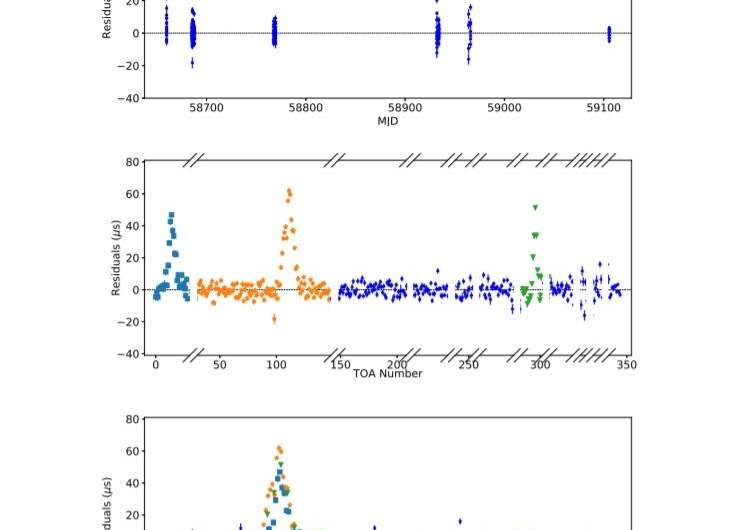September 21, 2021 report
'Black widow' pulsar detected in globular cluster NGC 6712

Using the Five-hundred-meter Aperture Spherical radio Telescope (FAST), astronomers have discovered a new pulsar in the globular cluster NGC 6712. The newly found object is a so-called "black widow," and the first radio pulsar identified so far in this cluster. The finding is detailed in a paper published September 14 on arXiv.org.
The most rapidly rotating pulsars, those with rotation periods below 30 milliseconds, are known as millisecond pulsars (MSPs). It is assumed that they are formed in binary systems when the initially more massive component turns into a neutron star that is then spun-up due to accretion of matter from the secondary star.
A class of extreme binary pulsars with semi-degenerate companion stars is dubbed "spider pulsars." These objects are further categorized as "black widows" if the companion has extremely low mass (less than 0.1 solar masses); if the secondary star is heavier, they are called "redbacks."
Now, a team of astronomers led by Zhen Yan of Shanghai Astronomical Observatory, China, reports the finding of another black widow pulsar, which received designation PSR J1853−0842A. The object was detected in NGC 6712—a metal-rich globular cluster located some 22,500 light years away from the Earth.
"We report the discovery of the first radio pulsar associated with NGC 6712, an eclipsing black widow (BW) pulsar, J1853−0842A, found by high-sensitivity searches using the Five-hundred-meter Aperture Spherical radio Telescope," the researchers wrote in the paper.
According to the study, PSR J1853−0842A has a spin period of about 2.15 milliseconds and dispersion measure of approximately 155.125 parsecs/cm3. The results indicate that the pulsar is in a 3.56-hour compact circular orbit with a very low-mass companion (with an estimated mass between 0.018 and 0.036 solar masses) and exhibits eclipsing of the pulsar signal. Therefore, PSR J1853−0842A has been classified as an eclipsing black widow pulsar.
Follow-up timing observations of PSR J1853−0842A found that the pulsar is located about 0.14 core radii from the center of NGC 6712. The pulsar's spin-down rate was measured to be approximately 0.00239 attosends/second. The astronomers noted that the obtained value of spin-down rate supports the NGC 6712 membership of this pulsar.
Moreover, the study found that the electron density of the eclipse region of PSR J1853−0842A is about 1.88 million/cm3. The upper limit of the accretion rate from the companion object was also calculated. This value was found to be at a level of 3.05 × 10−13 solar masser per year. The astronomers noted that this result is comparable with some other known black widows.
Summing up the results, the researchers acknowledged that the radiation of PSR J1853−0842A has the possibility to be blocked at lower radio frequencies. They plan to test this assumption during future observations of this pulsar.
More information: Zhen Yan et al, An Eclipsing Black Widow Pulsar in NGC 6712 (2021). arXiv:2109.06754v1 [astro-ph.HE], arxiv.org/abs/2109.06754
© 2021 Science X Network





















